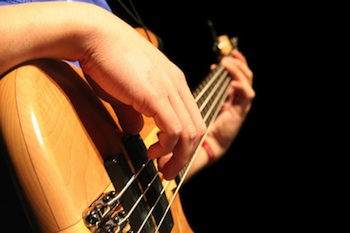When chord roots and melodies move in the same direction all the time, a vital sense of “independence” is lost.
________________
Download “The Essential Secrets of Songwriting” 6-eBook Bundle, and start building a large audience base for your music
________________
 For many songs, chord progressions are simple enough that the concept of a bass “line” doesn’t really happen. If your song’s harmonic rhythm results in you holding a chord for two bars or more before moving on to the next one, the bass may be somewhat inactive, dwelling on that one note. Adele’s “Rolling In The Deep” is an example of that. But if your song changes chords every two beats, let’s say, then the bass moves enough that you might think of what it’s doing as having the same characteristics of a melody.
For many songs, chord progressions are simple enough that the concept of a bass “line” doesn’t really happen. If your song’s harmonic rhythm results in you holding a chord for two bars or more before moving on to the next one, the bass may be somewhat inactive, dwelling on that one note. Adele’s “Rolling In The Deep” is an example of that. But if your song changes chords every two beats, let’s say, then the bass moves enough that you might think of what it’s doing as having the same characteristics of a melody.
What I mean by that is that the bass starts to move around, much like a countermelody. There’s a pleasant sense of musical freedom, as it were, that comes from hearing a melody and bass line acting independently of each other. Problems might arise when your melody always moves together with the bass, always in the same direction.
This issue, called parallel motion, can also be a characteristic that you’re going for. For example, Bill Wither’s “Lean On Me“, makes great use of the parallel octave motion between bass and melody, and has a very hooky attraction.
But as you can hear, that’s an effect. And like most effects, they’re great for one song, but become trite once you’ve done it. The issue of parallel motion is usually one that you want to avoid doing too much. Here are some tips for you to consider regarding chord progressions, melodies and parallel motion:
- Avoid parallel unisons, 4ths, 5ths and octaves between bass and melody. Those intervals are known as the “bare” sounding ones, and when a bass and melody move together by any of those intervals, the starkness that results is not always pleasant.
- Parallel 3rds and 6ths can be quite pleasant, and can go on for quite a while. But keep in mind that anytime you have constant parallel motion between bass and melody, even with a pleasant interval such as the 3rd or 6th, you surrender the sense of independence between bass and melody.
- Try to find ways to use a mix of similar motion and contrary motion between bass and melody. You should be able to isolate your bass line and melody, play them together, and hear moments where the bass and melody move in the same direction, then switch to moving in opposite direction, then back again, etc. That kind of freedom of line results in a pleasant musical effect.
- Using pedal point is a possible way to solve a parallel motion problem. If you’ve written a song where the bass and melody move too much together, and you’re not enjoying that sound, try seeing if simply holding a pedal point (i.e., holding the bass on one note) solves the problem. Here’s an example of a melody and bass moving together at the interval of a 5th, and here’s a pedal point solution.
____________
PURCHASE and DOWNLOAD the e-books for your laptop/desktop











You are welcome. I’m a bass player influenced mainly by 60’s soul and R&B. James Jamerson, Duck Dunn, Etc… What I like about your article was the pedal tone. Sometimes you work so hard working on a bass part for your song that you forget a pedaled note can be really cool. I love pedaling while the guitarist is changing chords over it. I like playing a moving part and then kicking into the pedaled note. adds a bit of drama to the song. In my opinion!
I absolutely love this blog! You are a definte wealth of musical knowledge. I’ll grab some tips for my own playing from you! Thanks
Thanks very much, I’m really glad you like the blog.
Cheers!
-Gary
This entry is great. While some songs intentionally use Parallel Motion and it sounds nice in that specific song, I hear it often enough that I see it’s being overused (most likely unintentionally). I come to the conclusion that the reason I like bands such as Rush and Iron Maiden is because of how awesome the bass sounds. It’s completely free, independent, of the melody. Yet the two work so well together.
I totally agree! I’m not a bass player, but I find that every band I’ve loved has had a really strong bass player who does more than simply play chord roots. They move around, creating a much larger and freer “sonic space”.
Thanks for writing,
-Gary
Pingback: FEATURED LINK: Chord Progressions, Melodies, and the Problem of Parallel Motion | Creative Music | Inspiring Musical Creativity